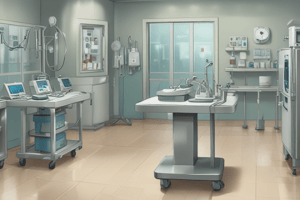Podcast
Questions and Answers
What is the primary purpose of CSSD zones in a hospital or healthcare facility?
What is the primary purpose of CSSD zones in a hospital or healthcare facility?
- To maintain a sterile environment for processing and storing sterile supplies (correct)
- To store medical equipment
- To provide a comfortable area for hospital staff
- To house hospital administration offices
Which CSSD zone has the highest level of cleanliness and sterility?
Which CSSD zone has the highest level of cleanliness and sterility?
- Sterile Zone (correct)
- Unrestricted Area
- Restricted Area
- Semi-Restricted Area
What is one of the key features of CSSD zones?
What is one of the key features of CSSD zones?
- Airborne Particle Counts (correct)
- Regular cleaning of floors
- Regular maintenance of medical equipment
- Food and beverage services
What is the purpose of Surface Disinfection in CSSD zones?
What is the purpose of Surface Disinfection in CSSD zones?
Why is Access Control implemented in CSSD zones?
Why is Access Control implemented in CSSD zones?
What is the purpose of Temperature and Humidity Control in CSSD zones?
What is the purpose of Temperature and Humidity Control in CSSD zones?
What is the purpose of Personal Protective Equipment (PPE) in CSSD zones?
What is the purpose of Personal Protective Equipment (PPE) in CSSD zones?
Which CSSD zone has no special requirements for cleanliness or sterility?
Which CSSD zone has no special requirements for cleanliness or sterility?
Flashcards are hidden until you start studying
Study Notes
CSSD Zones
CSSD (Central Sterile Supply Department) zones are designated areas within a hospital or healthcare facility that are designed to maintain a sterile environment for the processing and storage of sterile supplies.
Zone Classification
CSSD zones are classified into four categories based on the level of sterility required:
- Unrestricted Area: This zone has no special requirements for cleanliness or sterility. It typically includes areas such as offices, corridors, and storage areas.
- Restricted Area: This zone has some degree of cleanliness and sterility, but it is not as stringent as the sterile zone. It includes areas such asInstrument decontamination, sterile supply storage, and staff changing areas.
- Semi-Restricted Area: This zone has a higher level of cleanliness and sterility than the restricted area. It includes areas such as sterile instrument preparation, sterilizer loading, and sterile supply assembly.
- Sterile Zone: This zone has the highest level of cleanliness and sterility, where sterile supplies are stored and prepared for use. It includes areas such as sterile storage, sterile instrument packing, and sterile supply issue.
Key Features of CSSD Zones
- Airborne Particle Counts: Each zone has specific airborne particle count requirements to ensure a sterile environment.
- Temperature and Humidity Control: Temperature and humidity levels are controlled to prevent the growth of microorganisms.
- Surface Disinfection: Surfaces are regularly disinfected to prevent the spread of microorganisms.
- Personal Protective Equipment (PPE): Staff are required to wear PPE such as gloves, gowns, and masks to prevent contamination.
- Access Control: Access to each zone is restricted to authorized personnel to prevent contamination.
CSSD Zones
- CSSD zones are designated areas within a hospital or healthcare facility designed to maintain a sterile environment for processing and storing sterile supplies.
Zone Classification
- CSSD zones are classified into four categories based on required sterility levels:
- Unrestricted Area: no special cleanliness or sterility requirements; includes offices, corridors, and storage areas.
- Restricted Area: some cleanliness and sterility requirements; includes instrument decontamination, sterile supply storage, and staff changing areas.
- Semi-Restricted Area: higher cleanliness and sterility requirements; includes sterile instrument preparation, sterilizer loading, and sterile supply assembly.
- Sterile Zone: highest cleanliness and sterility requirements; includes sterile storage, sterile instrument packing, and sterile supply issue.
Key Features of CSSD Zones
- Airborne Particle Counts: each zone has specific particle count requirements for a sterile environment.
- Temperature and Humidity Control: controlled to prevent microorganism growth.
- Surface Disinfection: regular disinfection to prevent microorganism spread.
- Personal Protective Equipment (PPE): staff wear PPE like gloves, gowns, and masks to prevent contamination.
- Access Control: restricted access to authorized personnel to prevent contamination.
Studying That Suits You
Use AI to generate personalized quizzes and flashcards to suit your learning preferences.




